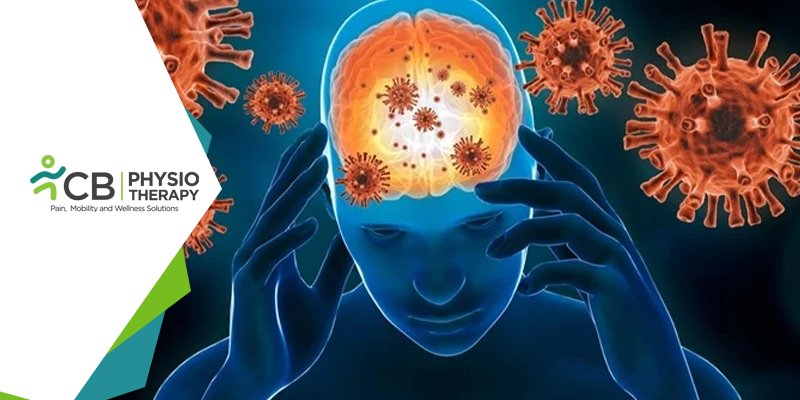Does anyone among your loved ones suffer from encephalitis? And do you want to help them to understand and adapt to the condition and simultaneously recover from this condition? Then, this can be achieved by advising them to follow a rehabilitation program. A rehabilitation program can help to provide a safe environment and gentle stimulation to encourage the process of spontaneous recovery. A physiotherapist is part of this rehabilitation team. A well-trained and experienced physiotherapist teaches self-care, work, and daily activities that help to improve the quality of life. Through this blog, we can throw some light on this condition and the various interventions used by physiotherapists to treat a patient suffering from encephalitis.
What is Encephalitis?
Encephalitis is the irritation and inflammation (swelling) of the brain. This condition occurs more often in the first year of life and decreases with age. Young and elderly patients are more likely to have severe symptoms. It can be caused by a viral infection, contaminated food or drink, mosquito, and other insect bites or coming in contact with an infected person, an allergic reaction to vaccinations, autoimmune disease, few bacteria, and parasites may also be a cause. It can also be caused by the herpes simplex virus, the leading cause of severe cases in all ages, including newborns, babies suffering from encephalitis may have a problem with swallowing, speaking, balance, and coordination. It can cause mild symptoms like cold or stomach infection, mild fever, mild headache, low energy, clumsiness, poor appetite, unsteady gait, confusion, sensory issues, problems with movement, and seizures. The signs and symptoms of patients vary from patient to patient. It can cause mild to severe symptoms, and there are rare cases in which this condition becomes life-threatening. Several studies have revealed that even patients with active SARS – Co V- 2 infections can suffer from encephalitis. Treatment is given to provide supportive care, rest, nutrition, and fluids that help the body fight the infection and relieve symptoms. Emotional support and reorientation for confused or delirious people may be helpful.
Physiotherapy management:
Encephalitis causes a variety of physical symptoms that can be improved by physiotherapy treatment. Physiotherapy helps the patient to return to normal life as soon as possible. It helps to regain and relearn the skills of everyday living. The physiotherapist suggests some modifications and advises keeping the home or workplace safe.
Physiotherapy begins with an evaluation, and assessment of the patient's medical history, range of motion, strength, neurological involvement, and functional level. And accordingly designs a treatments program according to the patient's needs.
Exercises:
Special exercises are recommended to the patient to help make the bones and muscles stronger. The physiotherapist uses various exercises to improve muscle strength, balance, overall flexibility, mobility, and motor coordination. The physiotherapist also teaches special skills so that patient becomes independent in activities like bathing, dressing, eating, cooking, driving, etc.
Massage therapy is a manual method used by physiotherapists that helps to restore movement and function of muscles and joints, It also improves circulation and eliminates metabolic toxins stored within muscles.
Acupressure:
Acupressure is a manual technique in which pressure is applied to the body on the specific, this relieves pain and promotes balance among the physiological systems. There are different acupressure points that correspond to different areas of the body. For example, when pressure is applied to the area between the thumb and forefinger, the intensity of the headache is decreased.
Aquatic therapy:
Aquatic therapy utilizes Hubbard tanks or whirlpools to allow individuals to exercise in a warm, buoyant, gravity-eliminated environment.
Transcutaneous Electrical Stimulation:
Transcutaneous electrical stimulation passes electrical currents through surface electrodes to provide pain relief and also helps in muscle re-education.
Thermotherapy enhances blood flow, increases the extensibility of soft tissues, increases the function of the tissue cells, and helps relieve pain.
Therapeutic ultrasound converts electrical energy into mechanical sound waves that provide heat to deeper muscles, tendons, ligaments, and bones.
Range of motion Exercises:
Simple range of motion exercises is done on regular basis to maintain movement and flexibility of joints and muscles. In the case of encephalitis in babies emphasis should be on practicing sitting up against gravity and crawling.
Fine Motor Exercises:
Fine motor skills exercises are used to improve cognitive function, especially in case these skills have been impaired. Some examples of fine motor exercises are therapy putty exercises, stretching rubber bands, stacking pennies, and Jigsaw puzzles.
Strengthening Exercises:
As the patient with encephalitis suffers some brain damage. The problems associated with brain damage are weakness in the legs, arms, and torso. Encephalitis baby may not be able to crawl or may have difficulties in sitting up and standing therefore strengthening exercises are done.
Stretching Exercises:
Stretching exercises are done to decrease stiffness and tightness in the joints. Also, passive manual stretches are recommended to maintain muscle length and range of movement.
Cognitive Exercises:
Physiotherapy helps to improve cognitive functioning, mental health, and memory. The brain is stimulated through an activity that causes more neurons to fire, which helps to keep the brain operating properly. It is especially important to exercise the brain so that it can engage neuroplasticity, which is the brain's natural ability to rewire itself. E.g. repeat numbers and letters, rhythm matching, card recall, color sudoku, etc.
Physiotherapy teaches tips and methods to minimize the symptoms and maximize their ability to grow and develop.

